 | |||
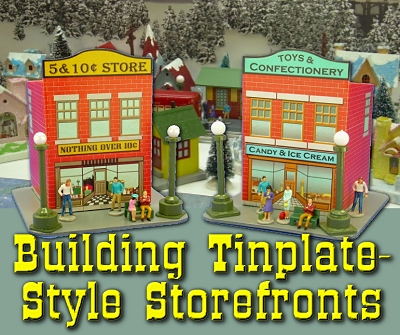 |  |  |
 |  |
 |  | ||
 |  | ||
 |  | ||
for Big Indoor TrainsTM |
|
|
Like the For this project, we chose a series of candy containers that were made in the early-to-mid 1900s by West Brothers. Each container included a glass full of candy that you could see through the house's "windows." A photo of the candy tin that inspired the drug store project is at the left. Creating multiple "different" buildings by changing the graphics on the same basic structure was a favorite money-saving device of several tinplate toy manufacturers. The three buildings we have so far are inspired by specific tins for which we found photos. Of course, once I designed one of these, I just had to design a couple more. In the meantime, Howard kept trying out different ways to use the designs and sending me his feedback. The main reason we don't have four or five structures in this article is that we ran out of time. I have plans for at least two more storefronts that I hope to get to eventually. If you sign up for our Trains-N-Towns(tm) newsletter, we'll let you now when we create and upload more storefronts or other projects you might find helpful. Building TinPlate-Syle Store Fronts - from Big Indoor Trains(tm)After Paul and I started creating our first Tribute to Tinplate(tm)" buildings, we both started combing the Internet for photographs of worthwhile projects. The problem isn't lack of examples; it's that there are so many to chose from. After the Vine-Covered Cottage project, which turned out to be fairly complicated, Paul wanted to pick one that would be different than any we had done so far, simpler to build, and reusable just by changing the graphics. So the West Brothers' tin storefronts seemed like a good next project. That didn't keep me from giving him plenty of feedback, though. Still, when Paul sent the final graphic files and I printed them on a good color laser, I couldn't help getting excited about this project, and about how it would look with my tiny but growing O gauge Marx railroad.What You Will Need
A Note about ScaleAlthough my Marx trains run on O gauge tracks, they are closer to S scale (1:64), the scale of S gauge American Flyer trains, and many collectible village houses. So I chose that scale to build these projects. If you're running larger equipment (like post-war Lionel, for example), you might consider the O scale version.What if You Need Something Bigger? - If you're running Large Scale (garden trains) or the old-fashioned Standard Gauge tinplate trains, you will need to contact Paul for the 1:37 version, the largest that these buildings can be printed out on most printers. Or you might be able to get a copy center to print the S-scale or O scale graphics at 2X on a large format printer (for 1:32 or 1:24 respectively) - the resolution of the graphics should be high enough to support that. But those files are just too big to host permanently unless folks start donating more toward Paul's Hard Disk Space fund. :-) If you want to be certain your project will look right with your existing equipment, consider doing a "mockup" first. Choose the scale you feel mostly likely to prefer, and print out a copy of Paul's graphics for that scale in black and white (saving your color cartridges). Then cut and fold the printout to make a mockup you can set next to your trains and other accessories before you begin the final structure. Print the PatternsThis project has a structure pattern that you will need to cut out and transfer to cardboard, as well as graphic sheets that you will use to finish the building's appearance. Again, doing a mock-up to make certain the finished structure will look right with your existing equipment is very important.Note: For this project, we have provided the patterns only in S scale, the scale we used for this project. Go ahead and print out the patterns, though, as they include the measurements for O scale. If you need additional measurements for an O-scale project, you can get them from Paul's graphics. Be sure to measure between the "fold lines" when you're measuring horizontally, though. You may print the structure pattern on any sort of paper, since you're simply using this to transfer the plan to your cardboard medium. However the "lithograph" graphic should be printed on acid-free heavy paper or card stock. Note that Plans 1a and 1b are meant to be spliced together before you transfer the pattern to the cardboard. For Optimum Printing - For the lithographic "wrap," we have used professional "vector" graphics when possible, to make certain that you get the highest resolution graphic, whatever scale you use. In most cases, you can get the best result by right-clicking on the name of the graphic you need, then saving the pdf file to your hard drive. (That way if you accidentally print them at the wrong size, which is very easy to do on some printers, you don't have to download them again.) Then navigate to the folder where you saved the files and click on the file name. Adobe Acrobat Reader should open up. Make certain that the graphic is set to print at 100% ("scale to fit" or "fit to page" should not be checked). Structure Patterns
Store Fronts
Store Sides and BacksEach store front will also require one back, both sides, and one "extra" printout.Tar Paper/Flat RoofThese patterns are from another feature, so you'll have to trim them to size after you download them. Though I like the staggered pattern best, I did one of each of these, just for variety. Which one or ones you use is entirely up to you. It was common on structures like this to change up even the insignificant patterns when redrawing the graphics, so don't worry too much about consistency.
If you can't get the graphics to work the way you need them to, contact
Paul and ask him for help - that's his department. :-)
A note about Copyright - However you use these plans and graphics for your personal use, please keep in mind that the lithograph graphics are copyright 2009 by Paul Race and are not to be copied, re-used, republished, or repurposed without prior permission and appropriate credit. Commercial use without prior permission is illegal and expressly forbidden.
Building a "Mockup"You will save time and sanity in the long run if you print the graphics in low-res B&W first to make certain that the are the right size for the plans you have printed out and that they are the right size to go with the rest of your equipment.First, make certain that the plans you have printed are the same size as the graphics you have printed. Sadly, it is very easy to download all the right graphics, then click the wrong button (such as "fit to page") when you go to print. Worse yet, a few printer drivers make all of those decisions for you unless you click on the "advanced" button or some such. As silly as this step may sound, use cheap paper to print the plans, then print the graphics in draft mode in black and white (to save toner cartridges). You can try holding both sheets up to the light, but sometimes it's hard to get a complete "picture." Remember, when you score and fold the frame pieces, the actual structure should be a bit wider in each direction than the pieces you cut out, because you need to compensate for the thickness of the cardboard you are using. Paul's wall graphics extend the wall pattern beyond the fold lines to compensate for any minor differences, but don't count on that compensating for any major discrepancies. The best way to be sure you have plans in the same scale as your graphics is to fold the graphics along the fold lines, then cut them out and hold up to the frame pieces. Again, the frame should be slightly smaller, especially horizontally. If it isn't you should adjust the size when you transfer the plans to the card stock. Mismatched sizes between graphic and plans is a problem that is much easier to head off than it is to solve once you've cut out the building frame. Then while you have the cheap printout cut out anyway, tape or glue it together and set it alongside the stuff you already have to be sure it's the size you want. If not, select a different scale and try again.
[Ed note: Howard actually put together two mockups, one based on the first set of graphics I sent him and another using a graphic file supplied by David Farquhar, based on photographs of one of the original West Brothers structures. You can see that Howard wrote notes all over the B&W one and sent it to me with a list of suggestions; sending me your projects with a list of suggestions probably won't work for you as well as it does for Howard. To see David's website about his tinplate train hobby, click here:-) - Paul] Cutting and Scoring the Frame Pieces Once you are confident your frame pieces are the right size, use a Xacto-type knife and a straight edge to carefully score every place where a fold is indicated. Then cut the pieces out and fold them into a square. Once you are confident your frame pieces are the right size, use a Xacto-type knife and a straight edge to carefully score every place where a fold is indicated. Then cut the pieces out and fold them into a square.
Now it's time to temporarily fold the B&W graphics around the walls as a "sanity" check. If it helps you to actually put one together this way, go for it. Engineers have a saying "build one to throw away, you will anyhow."
Building the BaseIt was Paul's idea for the base to represent a sidewalk/curb around the building. It will eventually give you a very nice place to set figures, fire hydrants, lamp posts, and the like. To provide room for such accessories, it extends one inch out to each side and two inches out front.I made the base by laminating two pieces of the thin corrugated cardboard from Express Mail packages. You could laminate "matte" cardboard as well. The foundation should fit loosely inside the four sides of the building once it is assembled. Eventually, it will give you more surface for gluing the building down to the base reliably. That said, you don't want to glue the foundation to anything until the building is complete and you have checked the fit one last time. To finish the base, I used gray paint to represent sidewalk. Because I had used corrugated cardboard, I was careful to dab paint into the edges to fill in the gaps. I probably could have used vinyl spackling do accomplish the same thing. If you wish, you can draw thin black lines on the base in a grid pattern to represent the sidewalk pattern; I've done that on other structures but I haven't done it on these yet. Building the Crest and Support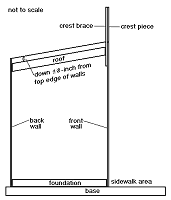 Technically, I could have made each storefront from one big piece of cardboard, including room for the "crest." As it turned out, it was easier for me to build the crest separately and fasten it on to the building front after I had the four walls glued together. I also added an extra layer of support to the crest, since it would be sticking out and more prone to "bumping." Plan 3 shows a side view of how I layered these pieces. Technically, I could have made each storefront from one big piece of cardboard, including room for the "crest." As it turned out, it was easier for me to build the crest separately and fasten it on to the building front after I had the four walls glued together. I also added an extra layer of support to the crest, since it would be sticking out and more prone to "bumping." Plan 3 shows a side view of how I layered these pieces.
By making three of these at the same time, I could work on one while the other one was drying, and so on. Let the building frames dry at least overnight before you start applying the graphics - the last thing you need is a joint popping or the frame getting wobbly while you're trying to be precise with the graphic. Applying the GraphicsThen I carefully applied the graphic wraps to one wall at a time. I started on the sides, then did the back and front. I could have started with the backs just as easily, but the front definitely has to come last. At my insistence, each of Paul's graphics includes a little bit of extra material at the edges to take up any "slack" in case your measurements are an eighth of an inch off or something. Before you cut off the fold lines, hold the wrap up to the wall it is going onto and see how close the fold lines are to the actual corners. If they're close, fold the first wrap (a back or side) along one fold line, then hold it against the wall you will be using it on. Then, if it is necessary, you can adjust the other fold. When you're certain your fold lines are where they need to be, crease them sharply and cut the white parts off of the graphic. Spread a thin layer of glue over the entire wall to be glued, and along the edges where the extra bits will wrap around the corner. Then fasten the graphic down carefully. Consider using clothespins or the like to make certain the wrap doesn't shift during the drying process. Once the first "wall" has dried, you add the next wall, except that one of your "fold lines" on the next wall should actually be a "cut line" if your graphic pages are fitting where they need to be. Remember you may also be trying to align mortar lines at the same time, so take your time.
Because I didn't cut the crest's shape out, the building's crest looks a little funny at first. I could have cut it out ahead of time, I suppose, but then I'd have an extra variable while trying to align the graphic for the store front with the left and right edge. Or worse yet, I'd discover that I had cut the crest shape wrong and have to start a building all over again. Trimming the CrestWhen the glue for the front has dried completely (meaning overnight at least), use a very sharp Xacto-style knife to trim the crest to match the shape of the graphic. Don't rush this job or try to cut all the way through both layers of cardboard on the first pass. Instead, make many light passes.
Applying the RoofOnce you have the structure glued together and all graphics applied, cut out a piece of corrugated cardboard or foam core to fit just inside the walls as shown in the photo above right. Choose and apply a roofing pattern, and when it is completely dry, fasten it in place. I fastened mine about an 1/8" down from the side and back walls. I actually applied the glue from inside the building, then brushed it into the seams where the roof fit the walls.Touch Up the Cut LinesWhen all the graphics are applied, take a marker or fine-tipped brush and touch up the edges of the cut graphic media with a color that is compatible with the bricks or stones.
Once you have tested all of the fits, it's time to glue your structure(s) together. Double-check the fit of the foundation inside each building, then glue it onto the base. I'd give it a few minutes to set before gluing the building down on top of it. Again, the hurry-up-and-wait aspect of this stage of the project is reduced if you are working on two or three buildings at once.
|






|


|

|  |
 |
 |  |  |
Note: Big Indoor Trains(tm), Big Train Store(tm), Family Garden Trains(tm), Big Christmas Trains(tm), Garden Train Store(tm), and Trains and Towns(tm) are trademarks of Breakthrough Communications (www.btcomm.com). All information, data, text, and illustrations on this web site are Copyright (c) 1999, 2000, 2001, 2002, 2003, 2004, 2005, 2006, 2007, 2008, 2009, 2010, 2011, 2012, 2013 by Paul D. Race. Reuse or republication without prior written permission is specifically forbidden.
Big Indoor Trains(tm) is a participant in the Amazon Services LLC Associates Program, an affiliate advertising program designed to provide a means for sites to earn advertising fees by advertising and linking to amazon.com.
For more information, contact us.

 Lewis Park Station
Lewis Park Station

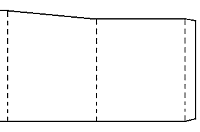














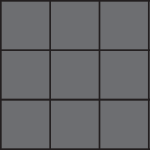



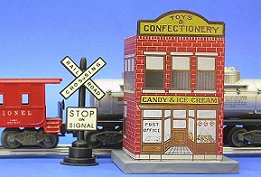












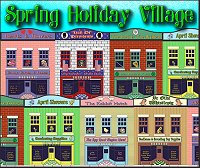
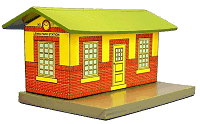 Building a Vintage "Lithograph" Station
Building a Vintage "Lithograph" Station
 Building a Tinplate-Inspired Lamp Post
Building a Tinplate-Inspired Lamp Post Building a Tinplate-Inspired Watchman's Shanty
Building a Tinplate-Inspired Watchman's Shanty Building a Tinplate-Inspired Railroad Crossing Sign
Building a Tinplate-Inspired Railroad Crossing Sign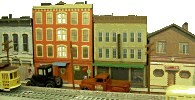




 Building the Union Station
Building the Union Station